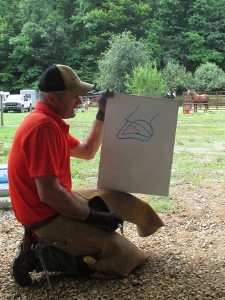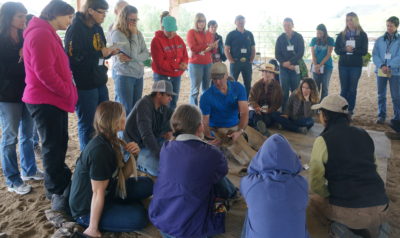single default post
Pearls Of Wisdom
Pete Ramey’s Pearls of Wisdom
PHCP mentor, Leslie Carrig, shares her experience attending Pete Ramey’s two-day clinic in Ventura, CA.
Hosting and Organizing the Event
PHCP recently hosted Pete Ramey in Ventura, CA. Jon and Sarah Smedley, of Trim and Train, did the hard work of organizing this clinic.
Pete has returned to his original two-day clinic format, only with a much smaller audience. The combination of lecture, discussion, and trim demonstration is perfect in a group this size. There were 40 in attendance with the majority being PHCP members.
Pete Inspires Hoof Care Providers
I have attended several of Pete’s clinics in the past and I’m always inspired by his “pearls of wisdom”. I would like to share some of what I took away from this clinic for those not able to attend and for those who just need a refresher.
- There is no Pete Ramey method because “if there is I don’t follow it”. All methods work somewhere and all methods don’t work somewhere.
- Don’t repeat something that isn’t working. Keep searching for solutions.
- Correct movement is needed to create a healthier hoof.
- The impact of the hoof on the ground is the main factor determining hoof form.
- Choose a correct impact (heel first or flat) during movement, over a correct angle when the horse is standing on level ground.
- The palmar angle may be trimmed to 5° when standing in the barn aisle but the horse may land at 25° (toe first).
- Leave that sole “ugly” with a layer of extra protection.
- Think about what you can leave on the hoof and trim only what needs trimming.
- Less trimming slows growth and excess trimming speeds growth up.
- Palpate those digital cushions and use this information in your trimming decisions.
- Collateral Grooves 101: To determine sole depth measure from the bottom of the CG to the perimeter of the sole (with a hoof pick or knife). A minimum sole depth at the apex of the frog would be 1/2 in, 12mm, or 1 female thumb width. ? At mid bar a minimum is 3/4 in, 18mm, or 1 male thumb width. (for those numerically challenged)
- Attend a Pete Ramey clinic for Collateral Grooves 102, once you understand CG 101.
- You can have a short hoof capsule with thick sole or a long hoof capsule with a thin sole. In the latter, the hoof capsule is vertically displaced.
- Keep in mind that 1/2 in of un-callused sole is far inferior to 1/2 in of callused sole.
- A heel rocker is a great way to offer a lower palmar angle to a club footed horse, while leaving the vertical height they may prefer. This true rocker will start at the bar wall junction and bevel towards the heels.
- “Rocker” type 2 is used on a foundered hoof and is not truly a rocker. The hoof appears to be rockered at the heel because there is missing material at the toe. This “rocker” will start at the point where the sole is the correct thickness, usually the widest part of the hoof. As the sole thickens in the toe, the “rocker” migrates forward and eventually disappears.
- Considerations for lowering heels (or not): 1. tension in the flexor muscles (stretch the leg forward to check if the knee can straighten) 2. frog health 3. digital cushion development 4. comfort in movement.
- Don’t over trim the correct side to match the incorrect side when trying to attain medial/lateral balance.
- Leaving the thickness of the hoof wall at a flare allows you to bevel it at the bottom and redirect the force inward.
- Be conservative when trimming bars. Trimming too much accelerates their growth.
- 90% of the hoof issues you come across are nutritional.
- Too many carbohydrates or a mineral imbalance will both create poor hoof quality.
- Educate your client on diet the 1st day. You won’t solve hoof issues with the trim alone.
- The hoof is like the “canary in the coal mine”. Let your client know that if the hoof is not healthy, the rest of the horse is not at its optimal health.
- Visit drkellon.com for more information on nutrition.
Mentors, Teachers and The New Generation
Whether you are a new student of the hoof or a long time mentor or teacher, there is something to be learned from Pete. It was fun to see a new generation of students inspired by his clear and thoughtful teaching and as a mentor I came away with some rediscovered and new thoughts to share with my students.


